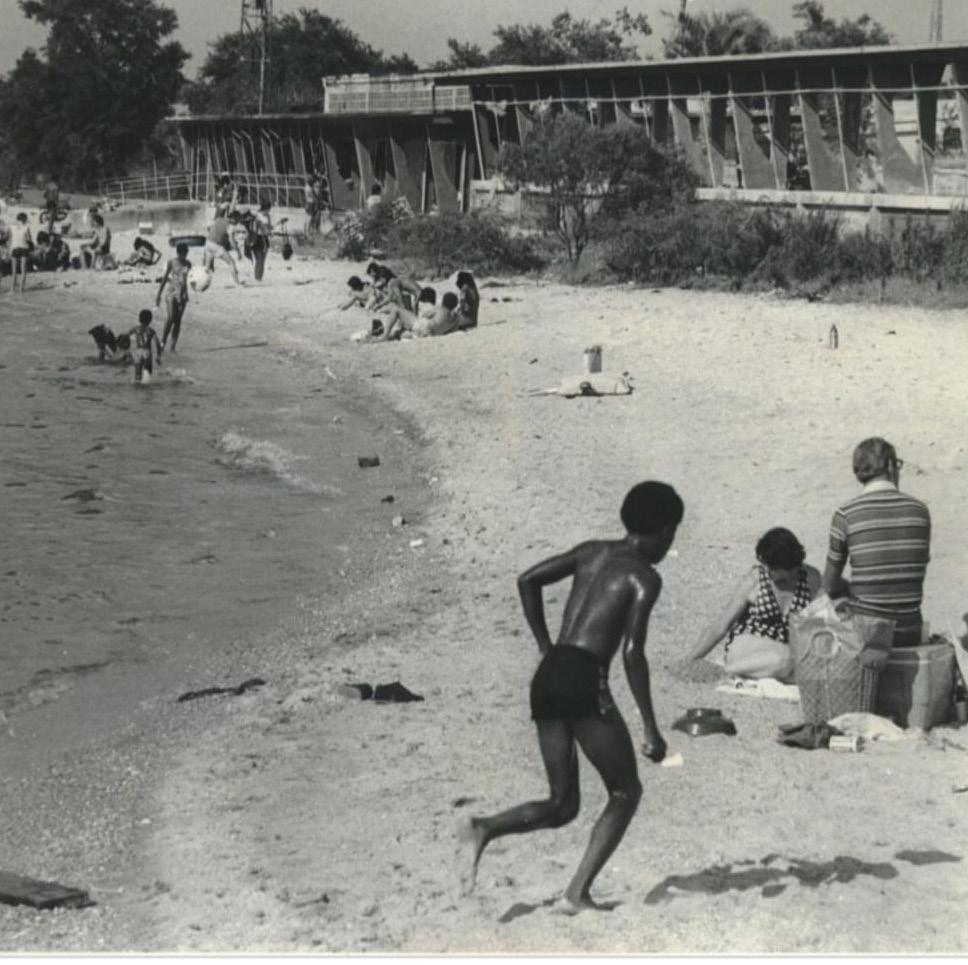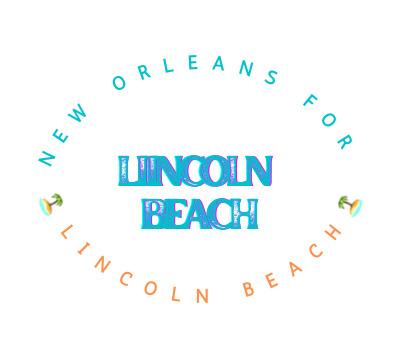LINCOLN BEACH Community Vision Report December 2022

We hosted a series of Community Visioning events in September and October 2022 to support residents in developing a collective vision for the future of New Orleans’s Lincoln Beach.
We collected stories, community values, drawings, and ideas at workshops, at a Community Vision Exhibition hosted at the new Lincoln Beach Center, and also through an online survey. This document presents the results, analysis, and design concepts from these events.
“How can we have economic and scientific development without polluting and exploiting the land and water?”
Workshop Participant
CONTEXT
As part of each workshop, participants explored and added to a timeline of New Orleans East and Lincoln Beach, from the 18th century to today. These are some of the images and community contributions to that timeline.


Images left to right: 1798 map of New Orleans showing Fort St. John and cypress swamps; Image of Maroon Communities; USGS map showing lakefront camps Below: Lincoln Beach and New Orle ans East development advertising


Before forced drainage and modern development, New Orleans East was swamp and marsh, and the lakefront a low-lying tidal environment. The lakefront has since been hardened into the concrete edge that we know today. In the middle of the 20th century, Lincoln Beach served the Black people of New Orleans as well as much of southern Louisiana.

Top to bottom: Thoughts shared by participants; Lincoln Beach; New Orleans East Matters protest and blighted property in New Orleans East; Lincoln Beach today and community activists at Lincoln Beach Opposite: At the workshops and with an online survey, we asked what kiind of place each person thinks Lincoln Beach
be.
Lincoln Beach closed in 1965 as the city desegregated.


Elders hold strong memories of this historic space, and younger generations have continually rediscovered the beach in the decades since. Today’s activists have led a multi-year effort to clean up the beach and to push for the reopening of the beach as a historic landmark and community space.



“Citizen engagement, Activism, Citizen Volunteers, Community Engagement, Clear mandate sent to government to act on citizens’ will.”
“Acknowledging our ancestors and having a place to return to.”
“I pray the beach is not privatized, it should be for the community.”
should









LAKE PONTCHARTRAIN HAYNE BLVD. RAILROAD LEVEE LINCOLN BEACH AERIAL How people get to the waterfront today WHAT SHOULD LINCOLN BEACH BE? A NATURE PRESERVE? AN ENVIRONMENTAL CENTER? A WATERFRONT PUBLIC PARK? A RESORT or AMUSEMENT PARK? remnant structures





OUTPUTS Personal Stories/Shared Histories Community Values Design Drawings and Collages Site Model & One Playscape Model! Hayne Blvd. Streetscape Stakeholders/Related Challenges September 22, 2022 September 24, 2022 2. DESIGN WORKSHOP 1. STORIES & VALUES DINNER VISIONING PROCESS & OUTPUTS Dinner Discussion Story Circles Identifying Shared Values Co-creating Design Drawings Site Model and Hayne Blvd. Design



of Co-created Design Drawing from Design Workshop
SURVEYS Co-creating a Timeline Sharing Thoughts and Stories Digital: Oct. 20 to Oct. 25, 2022 October 15, 2022
Example
3. EXHIBITION 4.
Community Input
WHO IS LINCOLN BEACH FOR?
Future 7% Families 6% Our Community 12% New Orleans East 10% New Orleanians 12%
Black / BIPOC 16%



WHAT IS THE IMPORTANCE OF LINCOLN BEACH?
Fun / Rec / Enjoy 15% Youth / Family 16% Nature 13%
All / Everyone (who respects) 37%
SHOULD LINCOLN BEACH
Peace / Healing 12%
Equity 8% History / Culture 27% Economic Development 10%
We collected input from 94 people at three public events. Additionally, 19 people responded to the online survey. We analyzed response from surveys, three free response questions, and reactions to possible precendents. In addition to answering questions about the types of activities that they wanted to see, many people responded with thoughts on how Lincoln Beach should feel.

HOW
FEEL? Spiritual 13% Meaningful 5% Safe 13% Relaxing / Leisure 13% Play 13% Nature 23% Fun / Enjoy 20%
WHAT KINDS OF ACTIVITIES BELONG AT THE BEACH? swimming, water sports environment, history music, performing arts vending, events family, intergenerational healing Recreation Education Entertainment Economic Development Community Health / Wellness
SHARED

Present
VALUES:

UNITY Safety/Security Fight gentrification Accesibility No exclusion/No corruption PROSPERITY Economic Development Seafood/Market Thriving Community RELATIONSHIPS Peace Life/Love/Youth Ancestry/History Spirituality/Gods Family/Respect BEAUTY/NATURE Clean water Sand/Breeze Ecosystem FUN Swimming Sports/Recreation Music
A key tension emerges from the many voices that spoke at the community visioning events, between keeping the wilder, less developed aspects of the beach as it exists today and building towards the more formal, developed space that it once was. Past
What values should guide the reopening of Lincoln Beach? These came out of the initial stories and values dinner. We used them in the community visioning events that followed to guide design and analysis.
Design Analysis
We traced and analyzed all 10 of the drawings that participants co-created at the visioning events. 5 of those drawings are represented and analyzed here.
Circulation Paths Gathering Areas

Forest/Wetland Areas
Beach Access
Activity Zones
Design Principles
Based on our analysis and all of the community inputs, a few key principles and priorities emerge
1. Protect the waterfront as a sacred and historic space.
2. Pathways and public spaces feel as if they are set amongst trees and wetland areas. The site should still feel forested.
3. Activities occur in distinct zones connected by pathways and trails. Activities support play, learning, growth, health, and collective well-being.

4. Each person is a steward of the land and water, and relationships between humans and other species.
5. Hayne Blvd. is an important part of the redevelopment of Lincoln Beach, and of New Orleans East as a whole.

COMMUNITY VISION DIAGRAM
Based on analysis and synthesis of the drawn, written, and spoken inputs from diverse participants, we share here a vision for how spaces for formal recreational activities, forest and wetland areas, and access to water can be balanced to support more users and improved accessibility, while maintaining the special qualities of the site as it exists today.
This drawing is based on participant drawings and survey responses and uses the design princples identified on the previous spread. Most participant drawings kept formal activities away from the beach, to perserve access to water and open vistas as much as possible.

Tunnel Levee Hayne Blvd.: Streetscape Improvements, Tree Plantings, and Economic Development
Boardwalk and Piers Main Entrance Beach Forest & Trails Activity Zones Lake Pontchartrain Railroad Swimming Non-motorized Boating/Fishing Forest & Trails Wetland & Trails
activities and
planning
engagement,
values
Determination of the exact
structures that will make up the beach will come out of the formal master
process and further community
but this diagram shows how the
articulated through the community visioning proccess can take shape.
Swimming
NORTH
Beach
Activity Zones


Areas for active programming are carved out of the existing forest and wetland areas. These can include soccer, skating, camping, education/ vistors/community center, museum, stage, amitheater, festival grounds, arts/farmers market, vendors, food trucks, agriculture production, community gardens, gathering/picnic areas. Structures can be closed up or moved out of harm’s way in advance of hurricanes and storm surge.
Circulation
Pathways connect the entry area to activity zones and to the waterfront. Trails provide secondary connections between activity zones and support exploration of forest and wetland habitats. A boardwalk and piers improve access to the water.
Forest and Wetlands
Large green spaces ensure that the forested quality of the site as it exists today is not lost with redevelopment. Forests and wetlands support increased biodiversity as well as sustainable water management. They also serve as a buffer from storm surge.
Beach
Good access to the water for all New Orleanians is of utmost importance. The beach is a spiritual space for quiet, reflection, and healing.
It is also a recreational space for swimming and water sports such as sailing, canoeing, kayaking, and fishing.
Activity Zones Wetland & Trails
CITY OF NEW ORLEANS RFP PROCESS
NEW ORLEANS FOR LINCOLN BEACH
What’s Next?
Now
September 2023: Design and cost estimating work by Digital Engineering for parking lot, traffic signal, repairs to brick wall, and demolition of waterfront structure
January
Request for Proposals for Master Planning Process
January through April 2023: Bidding, Selection, and Contract Routing for Master Planning Process
to early
Master Planning Process by selected consultant
•
until
•
2023:
•
• 2023
2024?
December
Publish and distribute Community Vision Report
Everday Stewardship: Continue
care of
as
vital public space
Committees/Action Groups: Build
capacity
for
in
Communications: Group communications and media relations, storytelling and documentation
Research: Historic preservation and economic development, funding sources, ecology
Government accountability: Ensuring city-led planning and design processes are rooted in community vision and values
Art: Partner
Arts
on public art
Orleans for
today by
•
2023:
•
taking
Lincoln Beach
a
• 2023
the
of New Orleans
Lincoln Beach
regards to: •
•
•
•
with
New Orleans
QUESTIONS? WANT TO GET INVOLVED? Connect with New
Lincoln Beach
emailing neworleansforlincolnbeach@gmail.com
Stories and Values Dinner on September 22, 2022
New Orleans for Lincoln Beach is a nonprofit formed in 2020 that focuses on ensuring community engagement in the development of Lincoln Beach.
Website: neworleansforlincolnbeach.com
Instagram: @neworleans_for_lincolnbeach
Facebook Group: New Orleans for Lincoln Beach
Water Leaders Institute provides resources, training, and networking focused on deepening New Orleanians’ understanding of water and water infrastructure. WLI facilitates communitydriven processes that support living with water, environmental stewardship, and climate adaptation.

Website: waterleadersinstitute.com
Instagram: @waterleadersinstitute
Report contributors: Aron Chang, Katie Fronek, Quanita Kendrick, Abraham McNeil, Tricia ‘Blyss’ Wallace
Images: Christine ‘Cfreedom’ Brown, Cris Guidry, Maggie Hermann
Visioning Organizers, Facilitators, Translators, and Documenters: Tricia ‘Blyss’ Wallace, Kristal Jones, Sage Michael Pellet, Reggie Ford, Aron Chang, Katie Fronek, Quanita Kendrick, Amy Stelly, Tap Bui, Mai Tran, Khai Nguyen, Charlie Crawford, Maria Muñoz, Abraham McNeil, Mia Kaplan, Maggie Hermann, Cris Guidry, Christine ‘Cfreedom’ Brown
We also thank the NET: East, Youth Empowerment Project, Janet Tobias, Lincoln Beach Center, Gerod Stevens, and WBOK for their contributions.
This document captures key findings, values, priorities, analysis, and design ideas for the future of Lincoln Beach, shared by over 100 community members in the fall of 2022. These data and community vision will be included in the city’s Request for Proposals (RFP), in order to inform the creation of a full master plan and initial construction documents for Lincoln Beach.

We are thankful to each participant, and to Gulf South 4 A Green New Deal and LSU’s Reilly Center for Media & Public Affairs for their support.

December 1, 2022











































